This is a guest post by luthier Marcus Dominelli, Victoria, BC, Canada.
I’d like to discuss the basics of bracing used in classical guitar making. This article is intended for those who know little about how classical guitars are made; however, some experienced luthiers and musicians might find it of interest as well. It’s not possible to overview every type of guitar bracing in existence, my goal here is to briefly examine the common types, and some of the forces that have pushed the evolution of the classical guitar in new directions.
The soundboard bracing basically does two things. First, it stiffens the soundboard so as to minimize distortion of the top from string tension. Second, the bracing affects the sound of the guitar, and the string response.
The neck, back and sides, scale length, box size, string type, and many other elements affect the volume and tone of the guitar. But the intent of this article is to focus on the soundboard and how it’s braced, because it is this area which has the biggest affect on the over all sound. It is, in the truest sense, “the heart” of the guitar.
Ladder Bracing
Around 200 years ago, most guitars had what is often called “ladder bracing.” It’s probably the simplest form of bracing, consisting of struts glued in perpendicular to the grain of the soundboard. The guitars made by the famous French luthier Rene Lacote had ladder bracing. Here is a photo of an 8 string Lacote style guitar I made for the guitarist Murray Visscher.
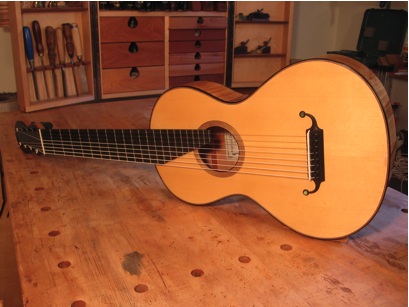
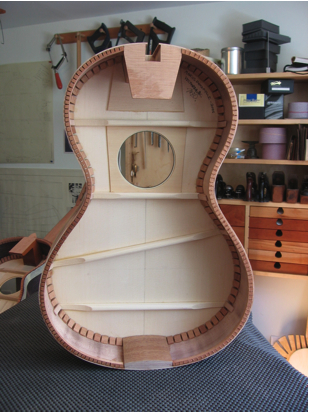
Many luthiers believe that asymmetrical bracing, such as pictured in this guitar, will resonate to a broader range of frequencies. I’ve found that excellent guitars can be made with either symmetrical or non-symmetrical bracing. As always in guitar making, a number of things are required to make a great sounding guitar. Well made ladder braced guitars like the ones made by Lacote had excellent clarity and projection, and could fill a concert hall as well as any modern instrument.
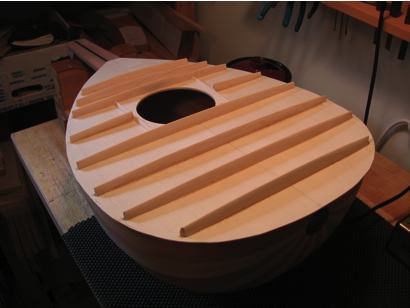
Many lutes also have ladder bracing. Here is a bracing photo of an Arabic lute, or “oud” that I recently made. It has many cross struts. Lutes and ouds are made with very thin soundboards, usually 1mm to 1.5mm thick, which gives them their characteristic tone. The best sounding ouds are made “under the brink of collapse”, with just enough bracing to keep them from imploding. It is said that they sound their best when made to these fine tolerances.
American steel-string acoustic guitar manufacturers used ladder bracing as well, although it was slowly phased out after the Martin Guitar Company invented X-bracing in the 1850’s. Ladder bracing did not withstand the high tension of steel strings very well. X-bracing was not only stronger, but produced a warmer tone and an all around better sounding guitar. Still, ladder bracing continued to get used on less expensive makes and models well into the 1950’s despite its shortcomings when used with steel strings.
Fan Bracing
Antonio de Torres (1817–1892) is generally given credit as the father of the modern classical guitar. He radically redesigned the instrument, giving it a larger body, lighter bracing and a thinner soundboard than did his predecessors.
The bracing pattern shown here, or slight variations of it, is the most widely used pattern in the classical guitar since the time of Torres. It is now commonplace, but 150 years ago it was truly revolutionary.
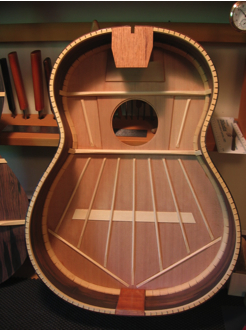
You can see from the picture how the braces are now running more in the direction of the soundboard grain, and not perpendicular to the grain like in the lute and many of the early 19th century guitars such as those made by Lacote.
This change in brace orientation is significant to the musician. Combined with the larger body and the thinner soundboard, fan bracing makes for a warmer, earthier sounding instrument with a much stronger bass response than the ladder braced guitars of the early 19th century. Simply put, Torres’ guitar had a greater dynamic range of tonal possibilities, and was a more versatile tool for making music. This image shows some variations in fan bracing patterns.
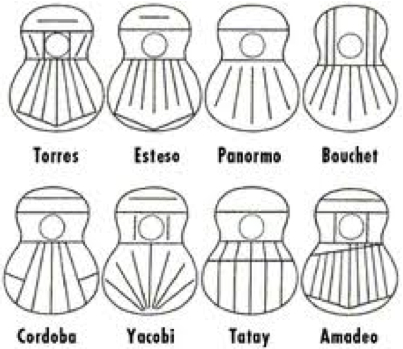
The Modern Concert Guitar
By the 1950’s, thanks in large part to Andres Segovia, the classical guitar had made its way into the concert hall. This really marked the beginning of the separation between the classical and the flamenco guitar, the latter evolving very little over the next 50 years to the present. Until around 1950 it could be well argued that there was little difference between flamenco and classical guitars in terms of design. I will not discuss it here, but this could be the subject of a future article.
The other significant change that happened in the mid 20th century was the advent of nylon strings. The nylon polymer was invented in the 1930’s by The Dupont Company. Prior to around 1950 virtually all classical players were using gut strings, and guitars were built with gut strings in mind.
Gut is about 20% denser than nylon, the net effect of which from the point of view of the musician is that nylon does not sound as bright. The problem for the luthier is how do we get that brightness back? One way is to increase the height of the bracing to stiffen the soundboard, thus enhancing the treble frequencies of the guitar, which many luthiers did.
Nowadays we have access to carbon strings, some of which are even denser than gut, but these have only been available for a few years. In the 50’s guitarists did not have a plethora of string choices like we have today, so luthiers they had to increase the stiffness of their soundboards to compensate for the mellower sound of nylon strings.
Further compounding the problem is the fact that the fan-braced Torres guitar tended to be more bass heavy in terms of balance. A good concert guitar needs to sound bright, clear, and articulate in order to project to the back of a hall.
Most luthiers will admit that it’s relatively easy to make a guitar with a strong, lush bass response, but making one with strong penetrating trebles is a much greater challenge. This was as true 60 years ago as it is today.
This switch from gut strings to nylon, and the need for a louder, bigger sounding concert instrument forced many luthiers to change the way they built their guitars. Let’s look at how one famous luthier responded to these challenges.
Jose Ramirez 3rd
Many will know the Ramirez name because it was Andres Segovia who played and endorsed Ramirez guitars for much of his career. Jose Ramirez 3rd had an interesting approach to making the concert guitar louder and brighter. He tried a number of things:
1) First, he stiffened up the treble side of the soundboard by introducing a new brace which, not surprisingly, has become known in lutherie lexicon as “the treble bar” as you can see in this diagram of his bracing pattern:
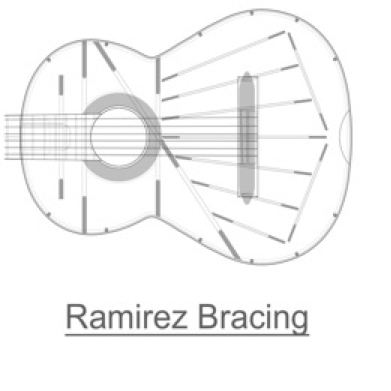
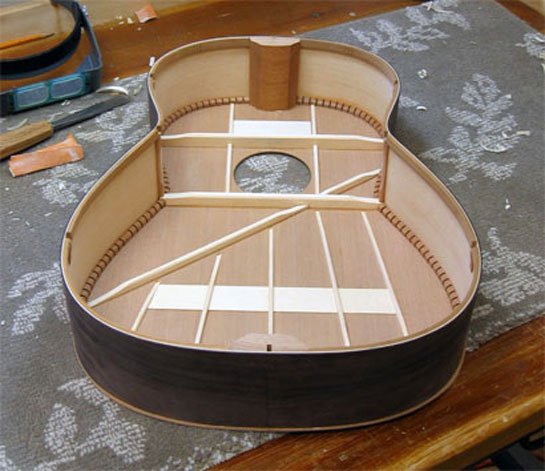
2) Second, Ramirez was the first manufacturer to widely use Western Red Cedar for soundboards, as you can see in the photo above. Cedar has some advantages over spruce, the main one being that cedar is on average about 15 -20% lighter in weight. Jose Ramirez 3rd believed so strongly in the superiority of cedar over spruce that he wrote in his book Things about the Guitar that “Stradivari would have used the American wood had he known about it.” The top in the above photo has a cedar soundboard with spruce bracing.
Prior to the 1950’s European spruce was the standard material for guitar tops. Nowadays cedar is more commonly used for classical guitars than spruce, although spruce remains an excellent soundboard material, many still preferring it to cedar for its tonal complexity.
3) Third, Ramirez commonly started using longer scale lengths on his guitars in an attempt to increase the volume. Scale length simply refers to the vibrating length of the string. Torres commonly used scale lengths of 640 to 650mm, which have become the standard. Ramirez guitars often had scales of 660, 664, and 668mm.
The physics of string length is fairly simple. A longer string is heavier than a shorter one. It takes greater tension to bring a heavier string up to the same pitch as a shorter string. The greater string tension of a long scale guitar equals more energy to drive the soundboard. If this energy is optimized with the design of the soundboard, it has the potential to make a louder guitar.
Although Jose Ramirez 3rd clearly made some progress in the evolution of the Concert Guitar, none of his developments can really be considered great departures from his predecessors. His addition of the treble bar was still only an improvement within the context of fan bracing; he did not truly invent a new type of bracing.
Also, it could be argued that his use of longer scale lengths was a backward step, if you consider how much more difficult longer scales can be for the player. Longer scale lengths don’t always translate into greater volume or projection in practice like they do in theory.
But to give Jose Ramirez 3rd credit, he pioneered the use of western red cedar and made it standard, and his use of the treble bar is still widely used today.
Radial Bracing
I’m not sure who to give credit to as the inventor of radial bracing. I’ve seen it used on Yamaha guitars from the 1970s. The luthier probably most well known for radial bracing is the late Richard Schneider, who worked in conjunction with Dr. Kasha, an American Physicist during the 1970’s and 80’s. There are many types of radial bracing. It is not commonly used compared to other bracing styles and I cannot make any generalizations about how radial bracing sounds, but many have used it with success.
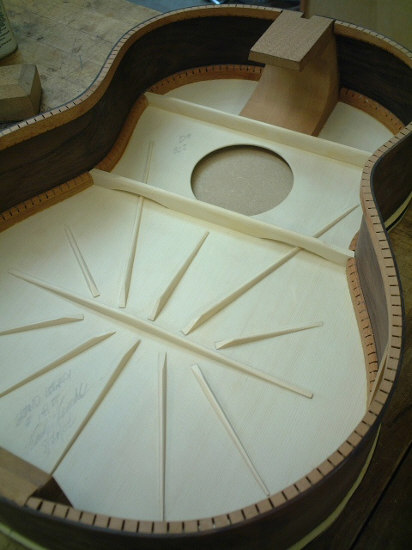
Lattice Bracing
In the late 1970’s, an Australian guitar maker named Greg Smallman popularized the lattice braced guitar. It was truly revolutionary, and his guitars to this day can be found in the hands of many of the worlds finest players. The basic physics behind how the lattice works is very simple:
Since a lattice structure is inherently stiff both with the grain and across it, the soundboard can be made much thinner and still be strong enough to withstand the string tension, thus substantially reducing the total weight of the top. The energy of the strings is more efficiently transmitted into soundboard vibration, the net result being a guitar with greater volume, and faster string response.
Another benefit of Lattice bracing is greater ease of playability and dynamics. By dynamics I mean the ability of the guitar to respond to both aggressive and gentle right hand techniques.
Playability is more than simply a function of adjusting string action at the nut and saddle. Although string height has an effect on playability, how the soundboard responds to every subtle nuance of the strings and hands is probably more important to the musician than action height alone.
Here is an example of a lattice braced soundboard. The braces are made with laminated balsa wood and carbon fibre. The soundboard is spruce.
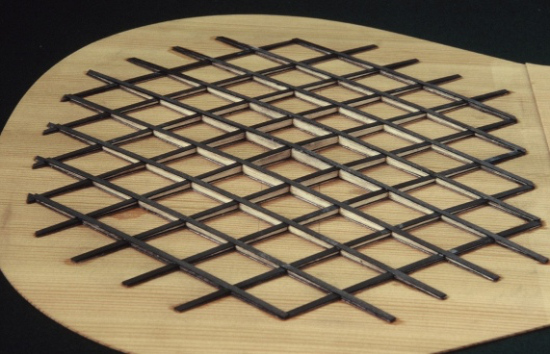
The picture below shows some of the design features you might find in a lattice braced guitar made in the Smallman style. The sides are laminated, and much effort has been made in the way of bracing and reinforcement to keep the rim and upper bout of the guitar as rigid as possible. The goal is to send all the string energy to the soundboard and minimize “leakage” to other parts of the guitar, like the sides, back, neck, and upper bout of the body.
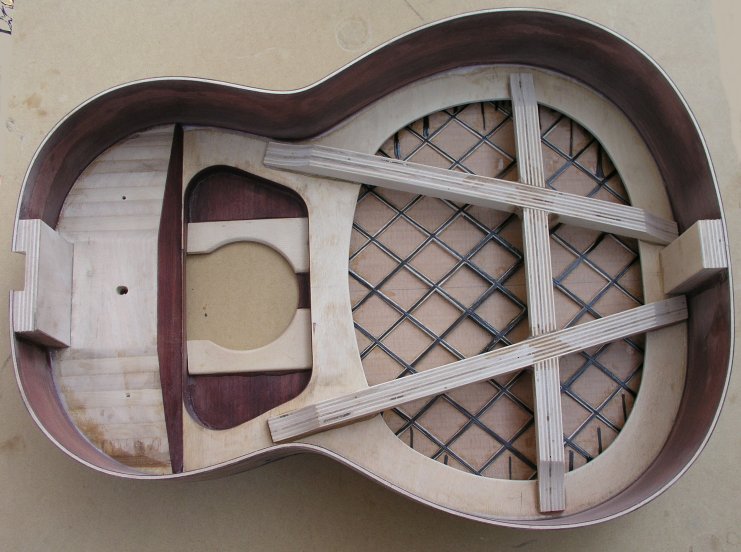
Criticisms of the Smallman Lattice Guitar
Many players have criticized the Smallman lattice as sounding too bright, nasal, or perhaps “banjoey” in quality. Its increased volume and ease of playability cannot really be challenged, but many players will argue that the tonal quality of the traditional fan braced classical guitar is still superior.
Carbon fibre is stiff, lightweight, and dimensionally stable, making it an excellent structural agent, but the more carbon fibre utilized in the design, the more the tone quality seems to suffer. This has led to refinements in the lattice concept over the past decade or so.
Nowadays there are almost as many ways to make a lattice braced guitar as there are luthiers making them. Some makers have simply combined the lattice soundboard with the traditionally made classical guitar body, using a wood lattice with traditional hide glue. Others see nothing wrong with using carbon fibre and epoxy resin in their constructions. The soundboard can be made very thin like the Smallman model, or thicker if the luthier wants the guitar to have a more traditional sound.
Today, the combinations are practically endless; making generalizations on how lattice guitars sound, as if they were all made the same way, is virtually pointless. You might love one and dislike another, as with any instrument.
This soundboard is lattice braced as well, but the bracing has no carbon fibre, often being referred to as an “all wood” or a “hybrid” lattice.
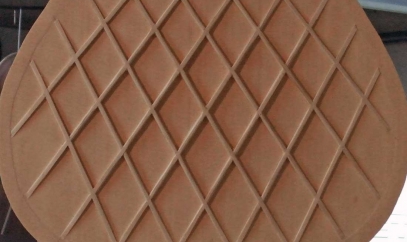
Double Top Guitars
It should first be understood that a Double Top Guitar does not denote a particular bracing pattern per se. In fact any type of bracing pattern could be used with a double top – fan bracing, lattice, ladder, radial, or whatever. Double topping refers to the way the soundboard itself is treated. The bracing will be glued on after the double top is made.
Gernot Wagner and Mathias Dammann of Germany are credited as the luthiers who first used nomex laminations in classical guitars.
Double tops are made by laminating a material called nomex, between two ‘skins’ of solid wood, usually spruce or cedar, or a combination of each. Nomex is a kevlar-polymer honeycomb product originally designed for use in the aeronautical industry, although it now has more applications.
This photo shows what Nomex looks like. The luthier laminates (glues) nomex between two skins of wood, using either epoxy of polyurethane glue.
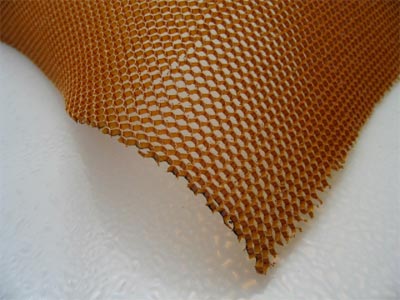
The picture below shows the first layer of wood, or “skin” with the nomex on top. Another layer of wood will be added to the nomex, thus “sandwiching” it between the wood layers. If done correctly, the result is a stiffer, lighter soundboard, although not nearly as thin as a Smallman style lattice top.
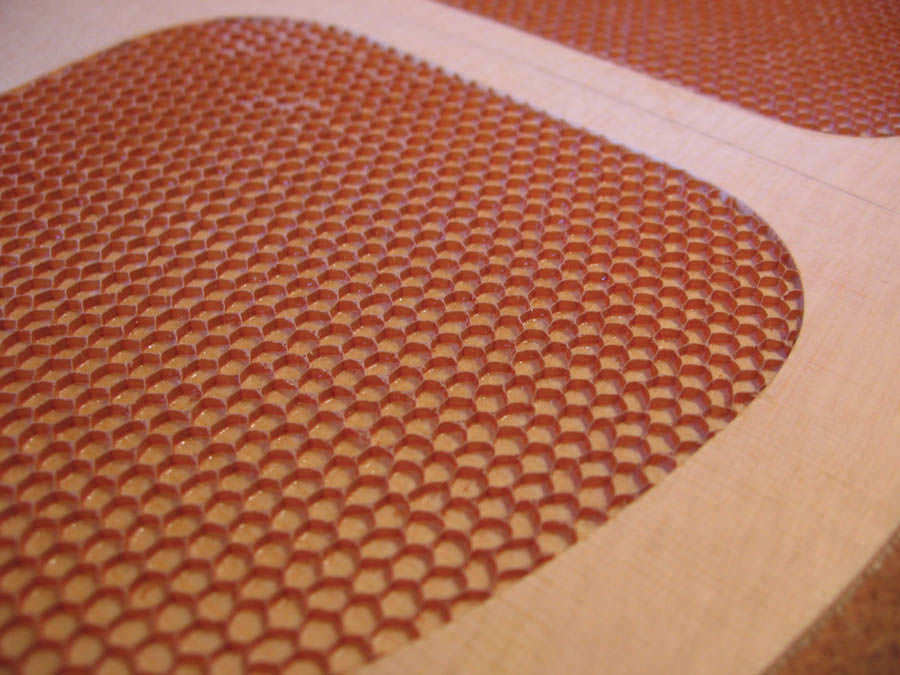
Conclusions
As you can see, the history of the classical guitar is one filled with innovation and change. The materials and technologies available to us open up new possibilities. And as musicians put new demands on the classical guitar, luthiers are ready to adapt, always trying to make the ultimate instrument.
The traditional Torres fan braced guitar, including all its variations has been with us over 150 years, and is still going strong. I have every reason to believe that it will continue to prove itself relevant.
The Early Romantic guitar, made by Rene Lacote, although not nearly as popular, has been around even longer, and musicians are still having these early 19th century guitars made or, occasionally restored so that they can play the music of this period on historically correct guitars.
The lattice braced guitar has always been a subject of debate among musicians, yet it has endured for over 30 years. More luthiers are finding ways to refine the lattice braced guitar so that its sound will appeal to more players.
Double top guitars have a shorter history. Although they were first made over 20 years ago, they’ve only been made in significant numbers in the last 5 or 10 years. I believe that double tops will go through a process of refinement over the coming years in the same way that lattice braced guitars are.
Superlative concert guitars seem to defy categorization, and no one type of guitar continually dominates over another type in the concert hall. I’ve been to many classical guitar listening events where concert guitars by some of the best luthiers are all played in succession by great players, in a concert hall.
The Guitar Foundation of America and the Guild of American Luthiers Conventions are good places to hear these comparisons.
Out of 30 or 40 guitars there are always half a dozen guitars that stand out from the others. And in that mix of best sounding guitars there are always some traditional fan braced guitars, lattices, and double tops. It’s almost as if the best guitars are born, not built.
I hope you enjoyed the article.
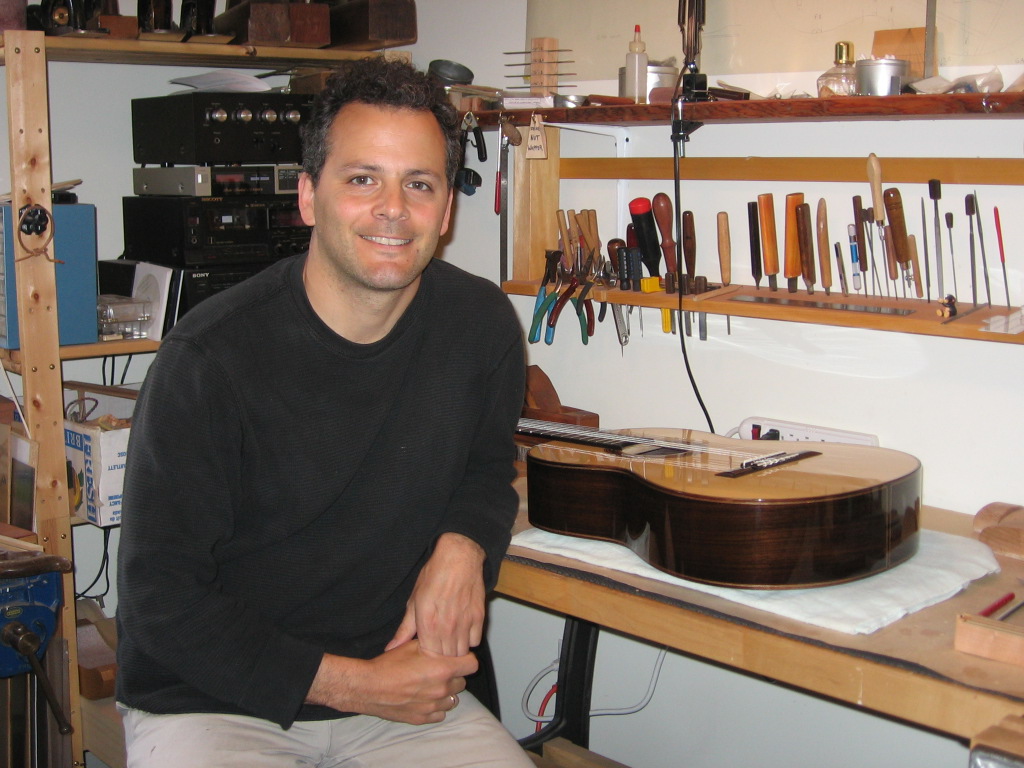
Marcus Dominelli
Victoria, BC, Canada
Thank you Marcus!
I’d like to personally thank Marcus Dominelli for this wonderful and educational guest post. I’ve owned three Dominelli guitars over the years and I currently play on a spruce/Indian rosewood fan brace guitar and a cedar/walnut lattice and love both of them. Marcus builds guitars with all the power of modern instruments but also an elegant sound that I continue to look for in an instrument. This article was previously published on Classical Guitar Canada. – Bradford

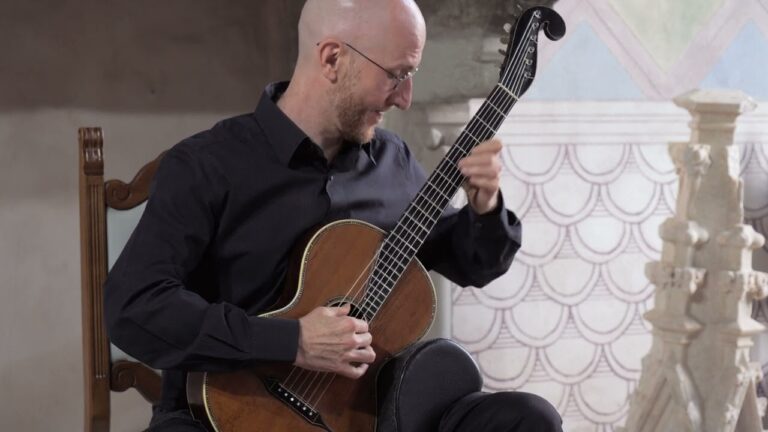
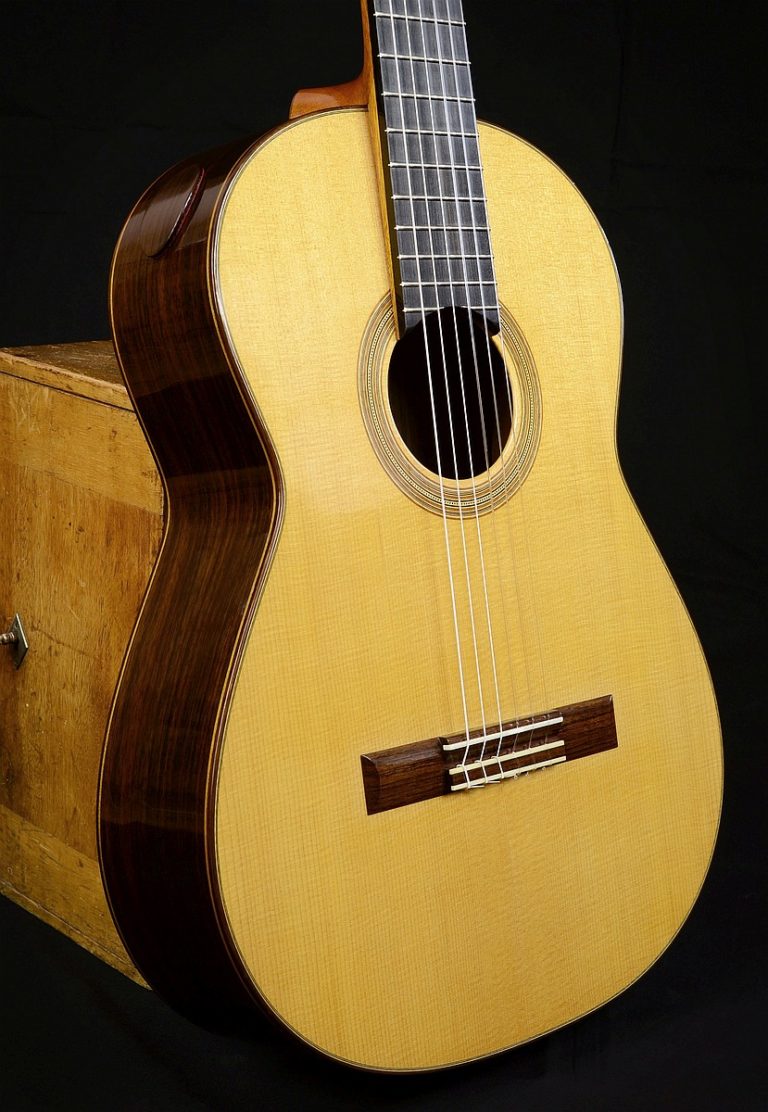
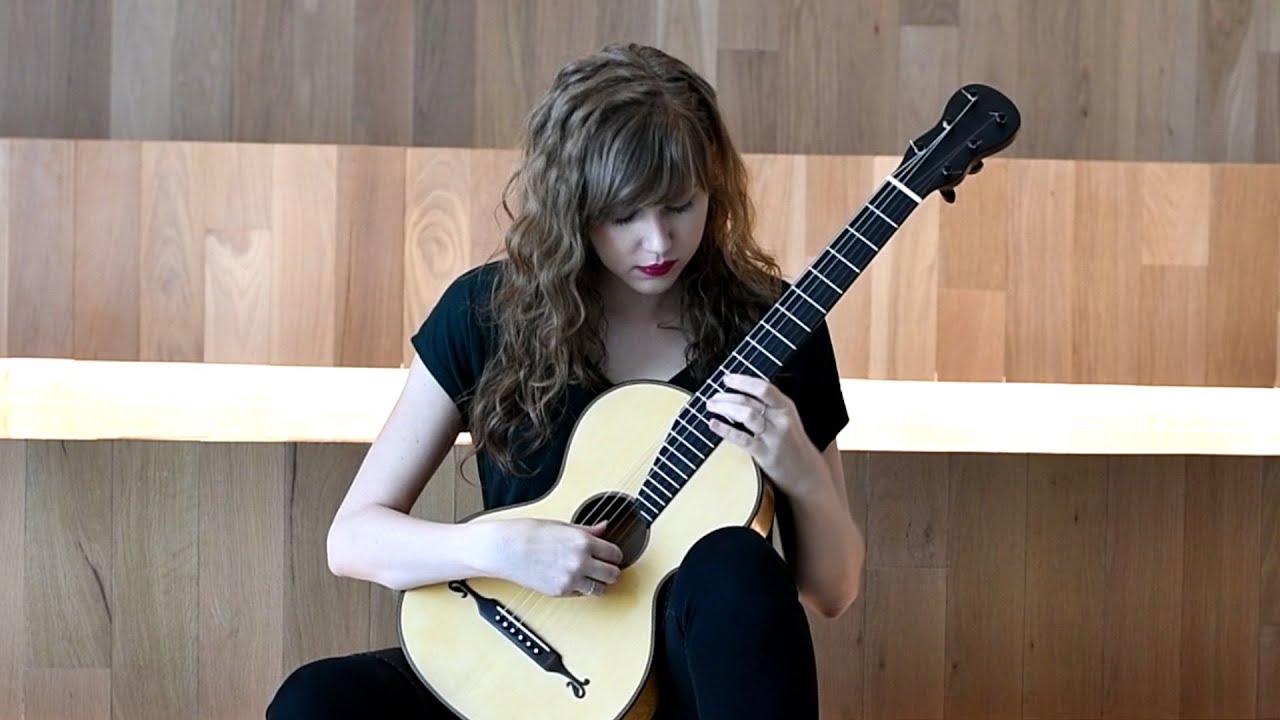
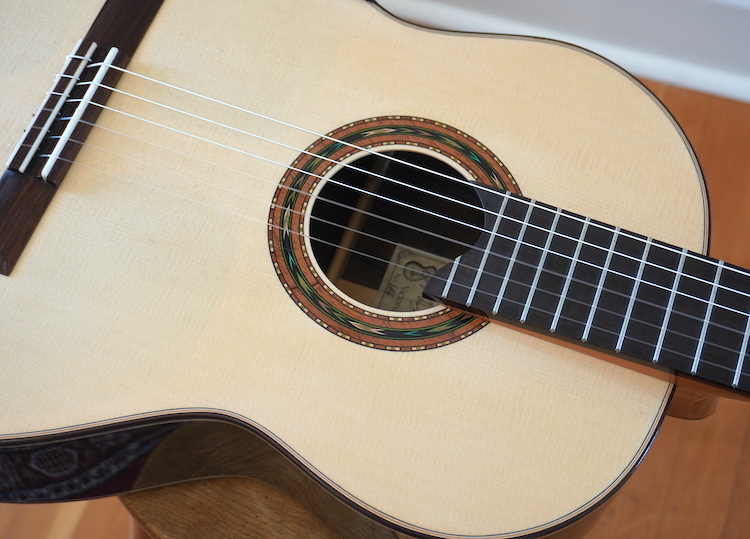
Hello, I enjoyed your article. I have some questions about the lattice bracing. I never see a bridgeplate on a lattice braced top. Is it not necessary. I guess a lattice braced top can be thinner, can you say how much thinner it can be in terms of percentage?
I’m not a luthier myself, maybe shoot Marcus an email over at his website, I’m sure he’ll have the answers you need.
Thank you, one of the best balanced, elaborate classical guitar history article today.
I wish the next article of you might be included “Laprevotte guitar” of the first guitar golden age 1820 – 1840, if you please…
since it was the fav guitar of Dionisio Aguado y García (the guitar in his portrait, he the good friend of Sor at Paris, 1827 – 1937…,)
said small guitar but played at a concert hall w/piano, violin, wo/microphone…?
some luthiers JPN (Kiyond Tanaka, Crane, etc.) claiming it has better projection at large concert hall than Torres type guitar?
(very simple two bars vertically parallel II bracing to the top, no bracing bars but arching back, ringer to the bracing top & back of “Martin’s f-hall steel string guitar in early 20th century”…don’t know why)
best regards w/ my respect
Thank you very much for the descriptive information.
This was very interesting and eye opening. Thanks a lot.
I’m a long-time player (classical) and recent restorationist yearning to build from scratch. Marcus
Dominelli’s essay was evenhanded. Too much is too often made of too little with regard to the minutiae of
of the guitar’s evolution. Large leaps count (ladder to fan bracing), but being objective about anything in the world of sound is dubious at best. Having a handle on what a piece of wood is likely to do is many years in the making. Perhaps more attention is paid to what a guitar looks like than should be the case; at the distance from which a listener usually sees, it is irrelevant.
Marcus — a very nice article and a solid introduction into the fascinating world of classical guitar bracing. I have just a few comments. First, I’m a builder, and I’ve built classicals with a few different bracing patterns. My first several guitars were built using a straight Torres/Hauser pattern. This is such a useful pattern, it still makes for amazing sounding guitars. I’ve built one guitar using a lattice pattern. My conclusions — I don’t care for it. Entirely too much work (I used wood bracing) and the result was a guitar that had good volume, but it just didn’t sound like a classical. It had a very neutral sound. Then I began experimenting with radial patterns. I developed one that is almost exactly like the radial pattern you show, even with the undercut transverse brace so the long fans could pass under, although I make my transverse brace more open than the one you show. Also, the center cross brace, I shape mine asymmetrically, where the peak occurs under the high E string. I think this helps with the trebles.
A comment about the Ramirez pattern and guitar you show. Ramirez’s pattern uses 7 fans, as shown in the drawing you have. But if you notice, that guitar has only 5 fans. The 5 fan pattern is a characteristic of Miguel Rodriguez’s top design. He uses that same long angle brace as Ramirez, the only real difference between the two being the number of fans.
Cheers!
That Lacote copy doesn’t looks like a Lacote to me.
Lacote doesn’t have those Cut-Away fingerboard after 12 fret. That design could be find on a Stauffer guitar or Fabricatore guitar.
There is only two fingerboard style for Lacote.
1. The flushed-into top fingerboard
2. The traditional one.
Thank you so much Marcus for this very informative article. It helps me a great deal as I am gaining better understanding my current Cervantes Fleta Concert guitar (wonderful), as well as searching for my next level concert guitar.
Comprehensive and enjoyable reading, thanks!
Once in a while, I read an article that is top to bottom written with clarity and great information. This is one of them. Thank you Marcus.
Thanks for the great articleI. I am interested in building a Hybrid ,nylon- string Acoustic Guitar like the Lowden Jazz, or Taylor 314 CE-N from an OM Kit I bought years ago but am at loss as to what Bracing pattern to use .Have you any ideas in this direction or can you point me in the direction of any relative literature.Direct contact with commercial builders has proven unsuccessful . Greetz
Niall Madden
Great article, very complete.
Can you help me with a decision. I want to buy a classic mid-range guitar. I am in doubt between 3 models of Prudencio Saez brand, G9, G11 and 280 (LATTICE BRACING). I also want to put the fishman pre-amp prefix pro blend in the model I will choose.
Anyway which one will I choose? the brand alhambra (7c, 7p or 7pA), or the Prudencio Saez models I mentioned earlier?
Thanks in advance.
Nuno from Potugal.
Very informative, unbiased and easy to read.
Very informative and important article which is easy to follow.
Thank you
Briljant article, I have learned a lot. So without prejudices, Not many people can do this.
I’m about to open my Cordoba 9 crossover to see what’s inside…!
Great informative article Marcus, Thank you.
Great point, please read the article about epoxy 3 D too http://www.ahlibeton.co.id/p/lantai-3-dimensi.html
Enjoyed the article. Thanks!
Wonderful informative article.
Thank you for sharing.
Kind regards
Tony